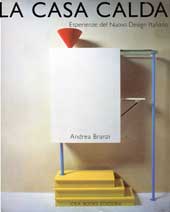 |
La casa calda
Esperienze del Nuovo Design Italiano
di Andrea Branzi
prefazione di Arata Isozaki
Idea Books 1984
156 pp. -- ill.
formato 23x28cm
isbn 8870170594
 |
sold out |
| |
|
|
| |
Andrea Branzi è tra i principali protagonisti del nuovo design italiano, per la sua intensa attività di progettazione e di teorizzazione in numerose pubblicazioni: tra queste "La Casa Calda. Esperienze del Nuovo Design italiano" è certamente il più conosciuto e tradotto (M.I.T. Press negli USA, Thames and Hudson in Inghilterra e L'Equerre in Francia). Nel libro l'autore raccoglie due secoli di ricerche delle arti applicate e del design, in collaborazione o in polemica con l'architettura. Il tema centrale del libro, partendo dalle polemiche riformiste del XIX secolo e dai dibattiti sulle arti applicate del movimento moderno, attraverso Bauhaus, Futurismo, Razionalismo, si focalizza sul design radicale e sulle ricerche degli anni Settanta e degli inizi degli anni Ottanta, fino alla proposta di un Nuovo Design rivolta alla progettazione di una civiltà domestica, alla ricerca di una "casa calda", cioè di un nuovo legame culturale e affettivo tra l'uomo e i suoi oggetti individuando valori quali il "valore emozionale, unico in grado di costituire un punto di riferimento all'interno dei nuovi consumi".
Dans son livre L'objet en question: la "casa calda", Andrea Branzi
analyse les tensions tout au long du XX° siècle entre l'urbanisme,
l'architecture et le design, entre l'espace de la ville, du bâtiment et celui de l a
maison, de la pièce (room), du mobilier, voire du vêtement. Ces conflits
irrésolus sont traversés par le "projet moderniste" né dans les années 20,
d'intégrer et de totaliser en un espace unique et uniforme les différents
espaces sociaux et les différentes fonctions sociales, depuis l'autoroute
jusqu'à la cafetière. On assiste à leur dissociation progressive et cahotique
depuis la fin des années 60 par la revendication d'une post-modernité.
Alain-Marc Rie, "Les êtres esthétiques de Don Judd o u le paradoxe de la chambre froide", revue Correspondances, n° 3, Strasbourg, septembre 1990
The Hot House is in part a manifesto and in part a noncanonical history of the most progressive and heretical experiments in the applied arts and design. Covering two centuries of avant-garde designs, but concentrating on the 1950s to the present, the book looks at architecture and urban design as well as graphic, interior, exhibit, industrial, and fashion design. It discusses the role that such magazines as Casabella, Domus, and Modo have played on this lively front, and provides an insider's view of such figures and groups as Alessandro Mendini, Gaetano Pesce, Alychmia, Global Tools, Michele De Lucchi, Ettore Sottsass, and—the design world's hot new movement—Memphis. It also elucidates such concepts as banal design, soft design, radical architecture, and color cultures, and relates these and other design developments to social and political issues.
Protagonist of many of these experiments, Andrea Branzi calls for a theory and practice in which the old methods and instruments—pencil, square, and compass—are rendered obsolete, and the formal commandments of modernism—comfort, function, and style—are banished. If Branzi's vision of the new domestic landscape bears any relation to the future home, the places we live and objects around us are on the verge of being radically transformed.
The Hot House dramatically expands the theoretical and operative limits of design. While precedents to Il Nuovo Design (The New Design) can be found in everything from Art Deco to De Stijl to Pop Art to California funk, Italy is the center of this new phenomenon and the "hot house" of its most intense activity. Beginning in the 1960s, there emerged a number of design studios that went by names like Archizoom, 9999, Superstudio, and UFO; their products redefined the basic architecture of furniture and clothing and polemicized an entire discipline.
The MIT Press; 1st MIT Press ed edition (December, 1984)
|
|
|
Translations of "La casa calda" have been printed by: M.I.T. Press (USA), Thames and Hudson (England), L'Equerre (France). |
| |
Rem Koolhaas ... Jacques Herzog ... Yung Ho Chang ... Steven Holl ... Toshiko Mori
|
|
|
postmedia • books |
|